
Eremophila divaricata, also known as spreading emu bush, is a flowering plant in the figwort family, Scrophulariaceae and is endemic to Australia. It is a shrub with stiff, spreading, tangled branches which are often spiny on their ends, erect leaves and mauve to lilac-coloured flowers.

Eremophila freelingii, commonly known as limestone fuchsia or rock fuchsia bush, is a flowering plant in the figwort family, Scrophulariaceae and is endemic to Australia. It is a shrub with sticky, hairy, lance-shaped leaves and flowers a shade of light to dark lilac and which occurs in Queensland, New South Wales and South Australia.

Eremophila scoparia, commonly known as silver emubush, is a flowering plant in the figwort family, Scrophulariaceae and is endemic to Australia. It is a broom-like shrub with narrow, hooked leaves, small sepals and deep lilac-coloured to white petals and is common and widespread in southern parts of the continent.

Eremophila bowmanii, also known as silver turkeybush, Bowman's poverty bush and flannel bush, is a flowering plant in the figwort family, Scrophulariaceae and is endemic to New South Wales and Queensland in Australia. It is a low to medium, spreading shrub with silvery-grey, hairy foliage and blue to lilac flowers, and sometimes grows in dense thickets with mulga.

Eremophila delisseri is a flowering plant in the figwort family, Scrophulariaceae and is endemic to an area of the Nullarbor Plain in South Australia. it is a shrub with lilac-coloured flowers and with most of its parts covered with white hairs.

Eremophila gibbifolia, commonly known as coccid emu-bush, is a flowering plant in the figwort family, Scrophulariaceae and is endemic to Australia. It is a small, rare shrub in the wild, found only in Victoria and South Australia. It has small, fleshy, lumpy leaves and lilac-coloured to purple flowers, spotted inside.

Eremophila mackinlayi, commonly known as desert pride, is a flowering plant in the figwort family, Scrophulariaceae and is endemic to Western Australia. It is a shrub with its branches and leaves covered with a thick layer of yellow to grey hairs, mostly egg-shaped leaves and deep lilac-coloured to purple flowers. It is most closely related to E. strongylophylla and E. hygrophana and sometimes occurs in the same areas as these species.

Eremophila strongylophylla is a flowering plant in the figwort family, Scrophulariaceae and is endemic to Western Australia. It is a small shrub with distinctive round leaves, yellowish new growth and purple flowers which are white inside. It is similar to Eremophila mackinlayi and Eremophila hygrophana but distinguished from them by characteristics including leaf shape, and the type of hairs on its leaves and branches.

Eremophila weldii is a flowering plant in the figwort family, Scrophulariaceae and is endemic to Australia. It is a shrub with glabrous green leaves, small sepals and purple or lilac-coloured petals and it occurs in arid and semi-arid areas of Western Australia and South Australia.

Eremophila microtheca, also known as heath-like eremophila, is a flowering plant in the figwort family, Scrophulariaceae and is endemic to Western Australia. It is an erect shrub with densely hairy branches and leaves, narrow leaves and pale lilac-coloured flowers and which emits a strong odour.
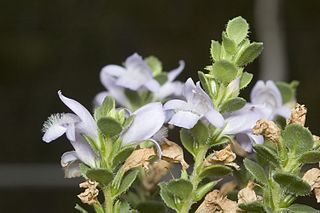
Eremophila behriana is a flowering plant in the figwort family, Scrophulariaceae and is endemic to South Australia. It was one of the plants collected on the 1858 - 1859 Babbage expedition to explore areas north of Adelaide and was later described by Ferdinand von Mueller. It is a small shrub, usually with egg-shaped, serrated leaves and lilac to purple flowers with hairs on the lower petal lobe.

Eremophila densifolia is a flowering plant in the figwort family, Scrophulariaceae and is endemic to the south-west of Western Australia. It is usually a low, spreading shrub with densely clustered leaves and lilac to purple flowers.
Eremophila elderi, commonly known as aromatic emu bush, is a flowering plant in the figwort family, Scrophulariaceae. It is endemic to central Australia where it grows near the border between Western Australia, South Australia and the Northern Territory. It is an erect, aromatic shrub with sticky leaves and branches and usually pale coloured to white flowers. Its specific epithet (elderi) honours an early Australian businessman, Thomas Elder.
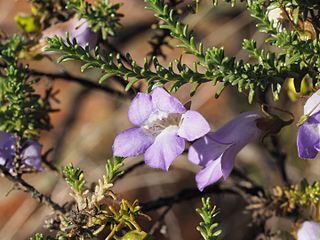
Eremophila exilifolia is a flowering plant in the figwort family, Scrophulariaceae and is endemic to Western Australia. It is a widely distributed shrub which is shaped like an inverted cone and has small, very sticky leaves and branches and lilac-coloured flowers.

Eremophila gibsonii is a flowering plant in the figwort family, Scrophulariaceae and is endemic to Australia. It is a sticky, glabrous, rounded shrub with narrow leaves and white to lilac-coloured flowers and which occurs in Western Australia, South Australia and the Northern Territory.

Eremophila goodwinii, commonly known purple fuchsia bush and Goodwin's emu bush is a flowering plant in the figwort family, Scrophulariaceae and is endemic to Australia. It is a small, spreading or erect shrub with most parts sticky due to the presence of resin, tapering leaves and pale lilac to mauve flowers. It occurs in New South Wales, the Northern Territory and Queensland.
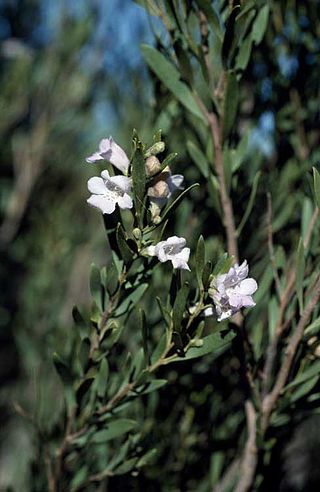
Eremophila paisleyi is a plant in the figwort family, Scrophulariaceae and is endemic to Australia. It is a rounded, broom-shaped shrub with white or lilac-coloured flowers which occurs in Western Australia, South Australia and the Northern Territory.

Eremophila phillipsii is a flowering plant in the figwort family, Scrophulariaceae and is endemic to Western Australia. It is a tall, erect, open shrub, with narrow leaves and lilac to purple flowers which are white with purple spots inside. It often has an offensive smell.
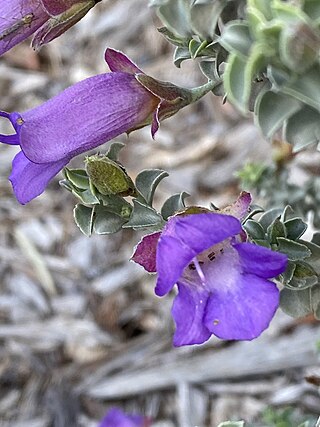
Eremophila rotundifolia is a flowering plant in the figwort family, Scrophulariaceae and is endemic to Australia. It is a shrub with many tangled branches with its leaves and branches covered with a layer of silvery-grey hairs. Its flowers range in colour from pale to deep lilac. It is common in South Australia and there is also a single record from the Northern Territory.
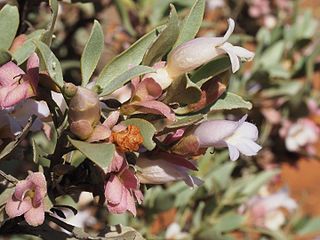
Eremophila tietkensii is a flowering plant in the figwort family, Scrophulariaceae and is endemic to Australia. It is a rounded to flat-topped shrub with grey-green leaves, usually pinkish-purple sepals and mauve, pink or lilac-coloured petals. It is mostly found in Western Australia but also occurs in the far west of the Northern Territory.


















